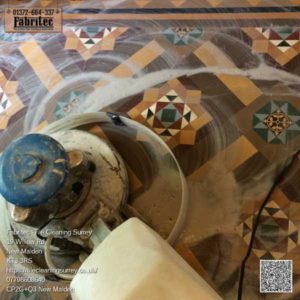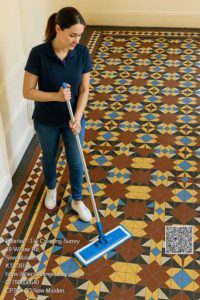Elevate Your Space with the Timeless Restoration of Victorian Tiles
Victorian hallway tiles bring a unique blend of historic charm and elegance to any interior, yet they demand consistent cleaning and maintenance to uphold their captivating beauty. Renowned for their intricate designs and vibrant colors, these tiles were integral to 19th-century architecture and continue to be a sought-after choice in contemporary homes. However, the natural wear and aging process poses particular challenges that require a careful and informed approach to ensure their preservation. With the right care and restoration techniques, you can revive their original splendor, allowing them to enhance your home's character for years to come.
Exploring the Cultural Heritage and Value of Victorian Tiles
Victorian tiles serve not just as flooring; they are remarkable artifacts that narrate a story of meticulous craftsmanship from the past. Made from resilient clay and adorned with stunning designs, these tiles encapsulate a rich legacy that is worthy of preservation. By restoring these historical treasures, homeowners play a crucial role in preserving cultural heritage while simultaneously enhancing the market value and visual appeal of their homes.
Recognizing Common Issues in Unattended Victorian Hallway Tiles
- Loss of Luster: A common problem with neglected Victorian tiles is the accumulation of wax, which many homeowners apply to enhance shine and protect surfaces. Over time, this wax buildup can obscure the tiles, leaving them with a dull and lifeless appearance. Insufficient maintenance of this wax can trap dirt and dust, further diminishing the vibrancy of the tiles and complicating future restoration efforts.
- Surface Damage and Scratches: Without proper cleaning and maintenance, scratches and discoloration can tarnish the surfaces of Victorian tiles. This deterioration is often caused by the presence of grit and dirt or by using harsh cleaning methods that erode the tile surface. The once brilliant colors and intricate patterns can become obscured, resulting in unsightly blemishes and a loss of the tiles' inherent charm.
- Fading of Historical Beauty: One of the most discouraging effects of neglect is the diminution of original charm found in Victorian tiles. Each tile was crafted with exceptional attention to detail, designed to enhance the room's aesthetic appeal. Over time, lack of care can result in faded patterns and washed-out colors, leaving your space feeling outdated and stripped of its historical allure.
Step-by-Step Guide to Reviving Victorian Tiles

Step 1: Effective Techniques for Wax Removal
The initial phase of the restoration process focuses on the careful removal of old wax layers using non-abrasive and tile-safe cleaning products. These products effectively lift the buildup without damaging the underlying tile, which is essential for restoring the tiles' natural beauty and clarity.
Step 2: Comprehensive Deep Cleaning for Enhanced Vibrancy
A specialized professional deep cleaning procedure targets stubborn grout lines, persistent stains, and trapped dirt, ultimately revealing the tiles’ original vibrancy. This crucial stage ensures that any discoloration is effectively addressed, allowing the tiles to regain their former glory and brilliance.
Step 3: Implementing Robust Moisture Control Measures
Older properties often lack adequate moisture barriers, making effective moisture control crucial. We use dehumidifiers or breathable sealers to preclude future moisture-related issues, ensuring that your tiles maintain their excellent condition for many years to come.
Step 4: Applying Sealer for Lasting Protection
To conclude the restoration, we apply a breathable impregnating sealer designed to shield the tiles from moisture and stains, ensuring their longevity and preserving their stunning appearance. This final step is vital for maintaining the quality and aesthetic of your tiles over time.
Crucial Maintenance Tips After Restoration
-
1. Choose pH-Neutral Cleaners for Optimal Tile Care
When it comes to cleaning your Victorian tiles, selecting the right cleaning products is critical for maintaining their appearance and protecting the sealant. pH-neutral cleaners are specially formulated to gently cleanse surfaces without stripping the sealer or damaging the tiles. These gentle cleaning solutions won’t cause abrasion, discoloration, or fading over time, ensuring the tiles remain vibrant and intact.
Recommended pH-Neutral Cleaners for Victorian Tiles:
- LTP Wash – Ideal for regular cleaning without compromising the integrity of the sealant.
- Fila Multisurface Cleaner – A gentle yet effective solution that is perfect for maintaining tile surfaces.
2. Establishing a Consistent Cleaning Routine to Prevent Grime Buildup

Even post-restoration, dirt, dust, and grease can accumulate over time. Establishing a consistent cleaning routine is essential for preventing buildup, ensuring your tiles remain visually appealing and vibrant. Regularly sweeping or vacuuming to remove dirt and debris, paired with mopping using a damp cloth, will keep your tiles clean and glossy.
- Tip: Use a microfiber mop for a gentle yet effective cleaning method that won’t scratch the tile surface.
3. Avoiding Abrasive Tools and Harsh Chemicals
When caring for your Victorian tiles, it is crucial to steer clear of using abrasive brushes, harsh scrubbers, or chemical cleaners that could damage the sealant or scratch the tile surface. Abrasive tools can leave behind unsightly marks, dulling the shine and making the tiles more prone to wear.
Items to Avoid When Cleaning:
- Steel wool pads
- Bleach or ammonia-based cleaners
- Abrasive scrubbing brushes
Instead, opt for soft, non-abrasive sponges or cloths to effectively maintain the tiles.
4. Timely Attention to Minor Wear and Tear
Over time, minor wear and tear on your tiles is inevitable, but there are effective ways to address these issues without compromising the overall finish. If you notice small stains or spots that resist removal through regular cleaning, it’s essential to treat them promptly to prevent further damage.
- Spot Cleaning: For persistent stains, gently rub the affected area with a mild cleaner and a soft cloth.
- Surface Scuffs: Light scuffs can often be buffed out using a microfiber cloth. For more stubborn blemishes, a thin layer of sealer can help restore the finish.
Tip: Do not delay in addressing spills. Staining liquids such as wine, coffee, or oil can set in quickly, making removal significantly more challenging later on.
5. Regularly Reapply the Sealer for Ongoing Protection
While the initial restoration involves sealing the tiles, it’s advisable to reapply the impregnating sealer every few years, depending on the level of foot traffic and wear. The sealer provides a crucial layer of defense against moisture, dirt, and grime that can otherwise infiltrate the tiles and lead to damage.
Steps for Effective Sealer Application:
- Ensure the surface is completely clean and dry before reapplying the sealer.
- Apply the sealer in thin, even coats, allowing each coat to dry fully before applying the next.
- Pay particular attention to areas with high foot traffic to ensure they receive adequate protection.
The Benefits of Investing in Professional Victorian Hallway Tile Cleaning Services
While many homeowners may consider DIY restoration, engaging a professional tile restoration service often yields far superior results. Professionals possess the necessary equipment, expertise, and understanding to manage the delicate nature of Victorian tiles, ensuring a successful restoration with minimal risk of damage.
Tile restoration specialists can offer:
- Comprehensive cleaning and restoration services tailored specifically for Victorian tiles.
- Expertise in moisture control and sealing to safeguard your tiles against future damage.
- Professional advice on effective long-term maintenance strategies for your tiles.
If you're contemplating the restoration of your Victorian tiles, seeking professional help can significantly improve the outcome, preserving the beauty and integrity of your flooring.
Need Expert Assistance? Connect with Professionals
While DIY cleaning is an option, hiring a professional ensures that no damage is inflicted on the original surface of your tiles.
Frequently Asked Questions About Victorian Hallway Tile Cleaning
What Cleaning Frequency Do My Victorian Hallway Tiles Need?
Light cleaning should be done weekly, while deep cleaning and resealing should occur every 1–2 years, depending on the levels of foot traffic.
Can I Use Bleach or Vinegar on My Victorian Tiles?
Absolutely not. These substances can erode the tiles and damage the sealant. Stick with only pH-neutral cleaners to ensure the integrity of your tiles.
Is It Necessary to Remove Wax Before Sealing?
Yes, wax removal is essential to guarantee that sealers adhere properly, providing long-lasting protection for your tiles.
Should I Consider Hiring a Professional for Tile Restoration Services?
For the best results and to avoid accidental damage, enlisting a professional is highly recommended.
The Enduring Allure of Victorian Hallway Tiles
Victorian hallway tiles are stunning pieces of history that, with the right cleaning and maintenance, can continue to captivate for generations. Whether you are restoring a home in Chertsey or simply refreshing your hallway, investing in the care of these unique floors is an undeniably wise choice.
The Article: Uncover the Shocking Transformation of a Neglected Victorian Hallway In Chertsey first appeared on https://tilecleaningsurrey.co.uk
The Article Victorian Hallway Tiles Cleaning Chertsey: How to Restore & Maintain Timeless Floors first appeared on https://fabritec.org
The Article Victorian Hallway Tiles Cleaning: Restore and Care for Timeless Floors Was Found On https://limitsofstrategy.com

